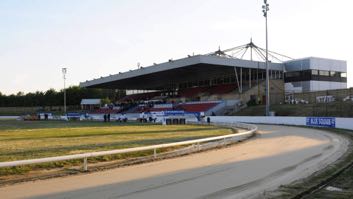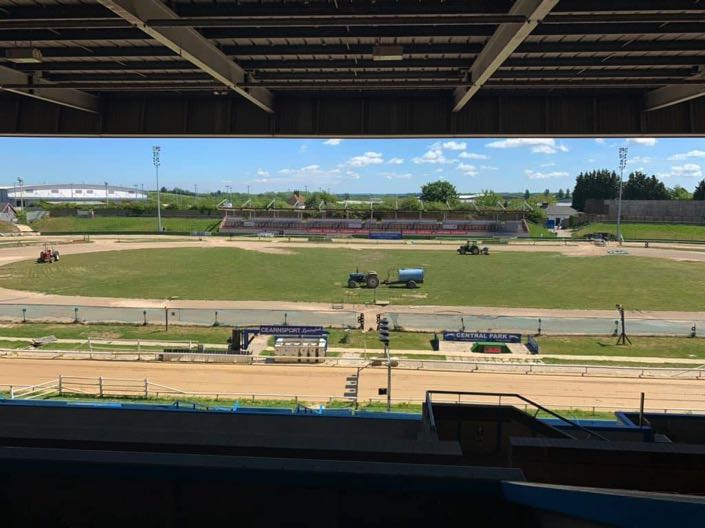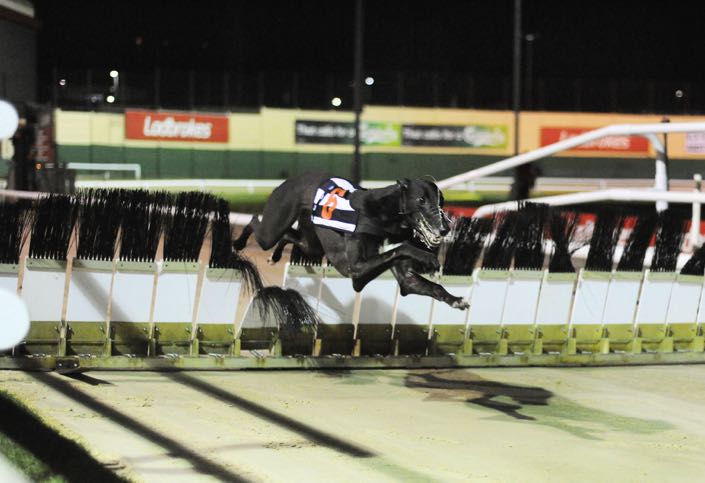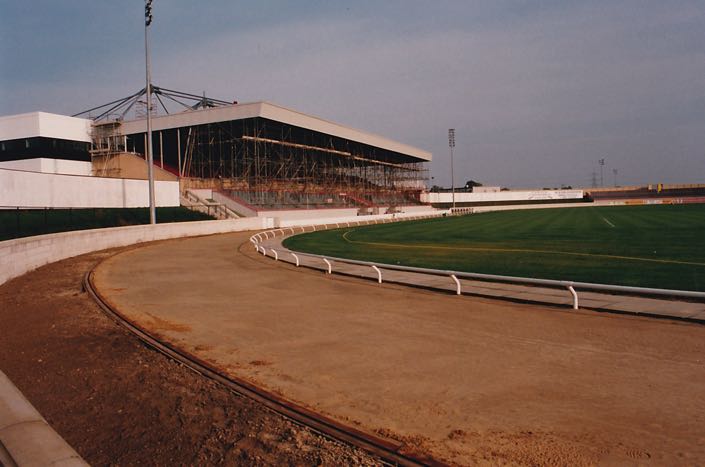- Address: Church Rd, Murston, Sittingbourne ME10 3SB
- Telephone: 01795 475547
- Website: centralparkstadium.co.uk

Formerly known as Sittingbourne Stadium, Central Park Stadium was built in 1990 and opened the same year. It is fair to say, therefore, that it is one of the most recent additions to the world of greyhound racing in terms of stadia. It used to be a football stadium and nowadays also plays host to speedway racing. Built to accommodate around 6,000 people, the stadium welcomed Sittingbourne Football Club when they sold the Bull Ground for £4.5 million and built a state-of-the-art ground on the outskirts of town that they named Central Park Stadium.
Financial difficulties for the club worked in the favour of greyhound racing, when it was sold to the council before being bought by a greyhound racing company. They leased it back to the club, who eventually decided to move to the place where they trained due to a lack of consistency over availability. In addition to the football and the greyhound racing, National League speedway racing has also taken place at Central Park Stadium over the years. At the time of writing, racing takes place on Monday, Tuesday & Thursday mornings, as well as Friday and Sunday nights.
The Track & Facilities

Built to accommodate a capacity of about 6,000 people, the Main Stand of Central Park Stadium has room for around a third of that amount. There are two terraced areas as well as a covered terrace opposite the Main Stand, which is something of a throwback to the days when the venue hosted football matches. If you want to enjoy some privacy whilst living the good life then you can get access to one of the four private suites on offer. If you want to enjoy a good night but not go quite that posh then you can head to the on-site restaurant.
The restaurant is trackside, meaning that you’ll have an excellent view of the racing whilst you’re there. If you don’t fancy living it up in quite such auspicious surroundings then you can make your way to one of the three bars that are located inside the venue. There are also fast food locations at Central Park Stadium, so you can get yourself a bite to eat without spending loads of money doing so. As you can imagine, the facilities are decent enough considering how relatively modern it is, though it’s fair to say that it has aged a little bit over the years.
At the time of writing, the following are the lengths of race that take place at Central Park Stadium, though this can obvious change at any moment. The track has a circumference of 443 metres.
- 265 Metres
- 450 Metres
- 480 Metres
- 500 Metres
- 642 Metres
- 708 Metres
- 893 Metres
- 943 Metres
- 265 Metre Hurdles
- 480 Metre Hurdles
Major Races & Events

Located as it is in the county of Kent, Central Park Stadium has benefited from the closure of other racecourses over the years. It has been able to take on other events as they have looked for a new home away from the courses that originally hosted them. In that sense, Central Park Stadium actually has more big events to its name than many similarly-sized greyhound racing venues. There are also some races, such as the Juvenile, which took place in Sittingbourne for a time before moving elsewhere more permanently.
Grand National
First run in 1927, the Grand National is one of greyhound racing’s original Classics. It moved from White City to Hall Green Stadium in 1985 before shifting to Wimbledon Stadium in 1999. When the Greyhound Racing Association let the race to leave its portfolio in 2012, it was taken on by Central Park Stadium. Run over 480 metres and involving hurdles, no dog has won it more often than Sherrys Prince, who win it successively in 1970, 1971 and 1972. In 2021, the winning dog’s connections took home £7,500 in prize money for winning the race.
Kent Derby
The Kent Derby is one of the youngest races run at Central Park Stadium, having been inaugurated in 2000. As the name suggests, it was based at the stadium from the word go and is a Category 1 race at the time of writing. Sponsored by Arena Racing Company, it is run over 480 metres and in 2021 the winner took home £6,500 in prize money. It has been sponsored by numerous different companies over the years, including John Smith’s, Ladbrokes and Cearnsport. Manera Spark is the only dog to have won it twice, doing so in 2004 and 2005.
Silver Salver
Known as the Thames Silver Salver when it took place for the first time at Southend Stadium, the Silver Salver was discontinued when that venue was closed in 1985. It was brought back at Canterbury three years later but was once again cursed by the closure of the venue in 1999. Sittingbourne was the new home for it in 2002, which is when its name was changed to the Kent Silver Salver. It wasn’t held between 2014 and 2016, returning in 2017 and then reverting to become a sprint competition. It’s run over 265 metres and in 2022 the winner took home £5,000 in prize money.
WJ & JE Cearns Invitation
The convoluted name of this race is down to the fact that it was run as the W.J. Cearns Memorial Trophy in 1951 after W.J. Cearns passed away. He was the founder of Wimbledon Stadium as well as being the chairman of West Ham United. It was run at Wimbledon until Roger Cearns, his grandson, brought it to Sittingbourne. ‘JE’ was added in order to honour W.J. Cearns’ father John, who was instrumental in Wimbledon’s history. It is run over 500 metres and Palace Issue won it three times between 1999 and 2001, becoming the race’s most successful greyhound.
Springbok
Inaugurated at White City Stadium in 1937, remaining there until the venue closed in 1985. At that point, it switched to Wimbledon Stadium, switching to its current home of Central Park Stadium in 2017. It is the leading competition for hurdlers, taking place over the obstacles over the distance of 480 metres. In 2022, the winning dog, Lenson Doolin, took home £5,000 for its connection. As with a lot of races in the world of greyhounds, it has enjoyed a number of sponsors over the years, including William Hill, Betfair and Cearnsport, with Arena Racing Company taking over in 2022.
In the News
If you ever look at the news section for greyhound racing stadiums, many of the stories are not positive ones. That is as much to do with journalists knowing that negativity sells as it is to do with the venues actually having negative things to say about them. It is therefore relatively good news that a quick search for Central Park Stadium brings up one main news story, which is that its owner, Cearnsport, was to be bought by Arena Racing Company. ARC already boasted a number of top-class stadiums at the time, including Newcastle, Perry Barr and Sunderland.
About Central Park Stadium

Central Park Stadium was originally intended to be a football ground. It was built by Sittingbourne Football Club after they sold the Bull Ground, which was located in the centre of the town, for £4.5 million. They planned to build a state-of-the-art stadium on the outskirts of town, which was named Central Park Stadium. The problem was that they overspent building it, leading to financial difficulties. This resulted in the need to sell the ground to the local council, with the club leasing it back. The council then sold it to a company that greyhound racing events.
The deal that saw the club leasing it was also agreed by the greyhound racing company, this time over seven years as that was a requirement of the Southern League at the time. When the club struggled to be able to guarantee the availability of the venue because of the greyhound racing, they made the decision to start playing their games at the complex where they used to train. This was named Bourne Park and opened in 2002. At that point, therefore, the venue became almost exclusively used for greyhound racing, which took place there for the first time in 1995.
It Becomes a Greyhound Venue
Greyhound racing should have taken place at Sittingbourne for the first time in 1994, but it was delayed when it emerged that the football club owed £1.1 million. There was also a need to repair a structural fault with the design of the stadium’s roof, which cost around £680,000 to fix. As a result, it didn’t open for greyhound racing until the start of October 1995, with a crowd of more than 2,000 turning up to watch it. New facilities there included licensed bars, a restaurant and fast food outlets, as well as three executive suites that were more private in nature.
More financial troubles reared their head in 1996, forcing the track to close as there was no promoter available to run fixtures. Roger Cearns re-opened the venue, transforming the way that it was run to make it a successful business, negotiating a deal that brought the Trainers Championship to the track for the first time in 1998. He also introduced the Kent Derby, securing a second Trainers Championship in 2000. A big decision was made in 2006 when a deal was struck with Betfair, resulting in ten Sunday meetings being screened on EuroSport.
The Stadium in the Modern Era
When Wimbledon Stadium closed in 2017, the Springbok and the Juvenile moved to Central Park Stadium, giving the venue an increased sense of profile. The two races offered their own prestige, with the Springbok being the leading competition for novice hurdlers and the Juvenile an invitational competition for the six best puppies in greyhound racing. A year later and a deal was signed with Sports Information Services, ensuring that racing would take place on Monday, Tuesday, Wednesday and Thursday mornings, in addition to Friday evenings.
More good news came to Sittingbourne on the back of bad news for another track when Towcester Stadium closed in 2018. The trainer Patrick Janssens moved to Central Park Stadium from there, winning the Trainer of the Year title two years later. In April of 2021, Roger Cearns, the promoter of the venue announced that Arena Racing Company had bought it. This brought the stadium into the modern era with a bang, given the extent to which ARC already owned a number of stadiums around the United Kingdom, therefore knowing how to ensure it was modernised.
Track Records
Each of the distances run at the venue has its own record for the track. Of course, these change all the time, not least of all because they stopped being held at all. Even so, at the time of writing, these are the records that have been set at the track over the years:
| Distance | Record Time | Date Set |
|---|---|---|
| 265 Metres | 15.99 Seconds* | 24th March 2019 |
| 450 Metres | 26.92 Seconds | 4th October 2016 |
| 480 Metres | 28.50 Seconds | 20th November 2011 |
| 500 Metres | 29.46 Seconds | 3rd October 2017 |
| 642 Metres | 39.33 Seconds | 24th March 2019 |
| 708 Metres | 43.70 Seconds | 2nd August 2009 |
| 893 Metres | 56.24 Seconds | 3rd October 2017 |
| 943 Metres | 60.18 Seconds | 18th July 2010 |
| 265 Metre Hurdles | 16.54 Seconds | 13th September 2019 |
| 480 Metre Hurdles | 28.97 Seconds | 22nd February 2017 |
*Record set during the semi-final of the Silver Salver